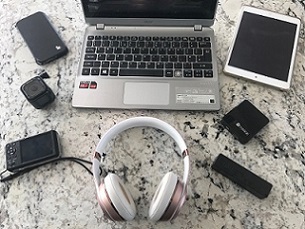 An AvSax thermal containment bag used on aircraft
An AvSax thermal containment bag used on aircraft
 All these everyday personal electronic gadgets are powered by lithium-ion batteries
All these everyday personal electronic gadgets are powered by lithium-ion batteries
 AvSax are now deployed on helicopters including air ambulances in the UK
AvSax are now deployed on helicopters including air ambulances in the UK
The most dangerous incident that can happen in the enclosed space of a passenger aircraft is fire and many are caused by lithium-ion batteries going into thermal runaway.
But what exactly is thermal runaway and why do passenger aircraft need equipment such as AvSax lithium battery fire mitigation bags?
All personal electronic devices (PEDs) such as mobile phones, iPads and laptops are powered by lithium-ion batteries which can go faulty and catch fire in a process known as thermal runaway.
This happens when one cell in a battery overheats it can produce enough heat – up to 900°C (1652°F) – to cause adjacent cells to overheat. This can cause a lithium battery fire to flare repeatedly and, because they burn at such a high temperature, they are very difficult to put out which is why AvSax battery fire containment bags are needed.
AvSax – the world’s best-selling lithium battery fire containment bag for PEDs on aircraft - are now on more than 15,373 aircraft operated by 80 airline companies.
Many helicopters have them too and they are now on-board the 22-strong fleet of air ambulance helicopters operated by specialist aerial emergency Babcock in the UK.
AvSax thermal containment bags have been used 33 times on aircraft to deal with emergencies worldwide since the start of 2017 and every time they have been deployed the aircraft has been able to complete its journey safely with no need to divert or make an emergency landing. Diversions can be very costly to the airline company and can even run into hundreds of thousands of pounds.
AvSax, which are also known in the industry as burnbags, firebags or thermal containment bags, were invented in the UK by Yorkshire company Environmental Defence Systems Ltd. AvSax won the prestigious Queen’s Award for Enterprise in the UK in 2018.
Paul Shearing from battery research company UCL has written a specialist paper on thermal runaway called Identifying The Cause Of Rupture Of Li-ion Batteries During Thermal Runaway and told Advanced Science News the many ways it can be triggered.
In short, he said it’s caused when the battery becomes faulty which generates heat at a faster rate than the battery can deal with, leading to “cell failures which are characteristically catastrophic.”
In short, they are very difficult to put out which is where AvSax comes in and why they are so widely used within the aircraft industry. They are made from military grade material so even if the device is so hot it explodes, it will be confined within the AvSax burn bag.
There are all kinds of reasons why lithium-ion batteries become faulty and go into thermal runaway. It can happen if they are cheap batteries bought on the internet which don’t meet safety standards or the batteries have been charged by inferior battery chargers.
A main problem on passenger aircraft is people losing their mobile phones down their seats. If they then move the seat to try to find the phone it can crush it, badly damaging the battery and sending it into thermal runaway.
This is why you often hear cabin crew warning passengers to tell them immediately if they have lost their mobile phone.
In the summer of 2021 there were more than 25 incidents of lithium batteries overheating or catching fire on planes in the USA alone – well over double the amount recorded in the same three months the previous year.
The report by the Federal Aviation Administration (FAA) in the USA revealed that 26 incidents involving batteries in everyday devices such as mobile phones, laptops, earphones and vapes were reported to them between the beginning of May and the end of August in 2021.
Only 10 incidents were reported in the same four months of 2020 and 15 in the pre Covid-19 pandemic year of 2019.
This means there have now been at least 350 aviation-related incidents involving lithium batteries carried as cargo or baggage recorded since January 23, 2006.